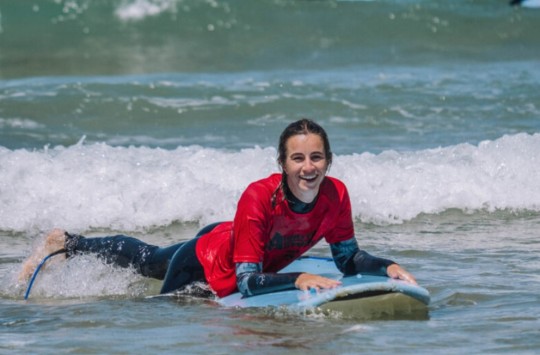Text
Surf Camp Portugal: Riding the Waves of Adventure and Tranquility

Discover the Ultimate Surfing Experience: Nestled along the stunning coastline of Portugal, Surf Camp Portugal offers an unparalleled opportunity to ride the waves of adventure. With world-class instructors and top-notch facilities, surf enthusiasts of all levels can immerse themselves in the thrill of catching waves amidst breathtaking natural beauty.
A Perfect Blend of Adventure and Relaxation: Beyond the exhilarating surf lessons, Surf Camp Portugal provides a perfect blend of adventure and relaxation. Indulge in yoga sessions on the beach, explore charming coastal towns, and savor delicious Portuguese cuisine. Whether you're a seasoned surfer seeking the best breaks or a newcomer looking to embrace a new hobby, this surf camp promises an unforgettable experience that rejuvenates both body and soul.
Unwind in Coastal Comfort: Picture yourself unwinding in coastal comfort at Surf Camp Portugal. Choose from cozy beachfront accommodations, where the soothing sound of the waves lulls you to sleep, or opt for eco-friendly bungalows nestled amid lush greenery. With a focus on sustainable practices and a vibrant surf community, this camp not only offers an exceptional surfing adventure but also fosters a sense of belonging and connection that will stay with you long after the waves have settled.
For More Information: https://algarvewatersport.com/
#wind surf camp#kitesurf school portuga;#wingfoil course lagos#kitesurfing#kitesurf lagos portugal#kitesurf school#kite surfing portugal#surf lessons
0 notes
Text
Learn kitesurfing with Algarve Watersport
What is kitesurfing
Kitesurfing, also known as kiteboarding, is an adventurous water sport that combines elements of surfing, wakeboarding, windsurfing, and paragliding. It involves riding a specially designed board across the water's surface while being propelled by a large kite. Kitesurfers harness the power of the wind by controlling the kite using a control bar connected to lines, which allows them to maneuver, jump, and perform various tricks.

The sport requires a certain level of skill and physical fitness, as it involves both board control and kite handling. Kitesurfers use the wind's power to generate speed and perform maneuvers, while the board allows them to ride waves, carve turns, and glide across the water's surface.
Kitesurfing can be done in various water environments, including oceans, lakes, and rivers, as long as there is sufficient space and appropriate wind conditions. It has gained popularity worldwide due to its exciting nature and the freedom it offers to riders to explore the water and perform tricks in the air. Safety precautions, such as using proper equipment, learning from certified instructors, and adhering to local regulations, are essential to ensure a safe and enjoyable kitesurfing experience.
How does the kitesurfing work?
Kitesurfing works by utilizing the power of the wind to propel the rider across the water's surface. Here's a step-by-step overview of how kitesurfing works:
Equipment: The basic kitesurfing equipment consists of a kite, control bar, lines, harness, and a board. The kite is the primary source of power and is controlled by the rider using the control bar, which is connected to the kite with lines. The harness is worn around the waist to distribute the pulling force of the kite, and the rider stands on a board designed for kitesurfing.
Launching: The rider starts by inflating the kite and laying it out on the ground or water. They attach the lines from the control bar to the kite and perform safety checks to ensure everything is properly connected.
Launching the kite: With the kite positioned in the wind window (the area of the sky where the kite generates power), the rider signals to a helper or uses a self-launch technique to get the kite airborne. The kite starts catching the wind, and the rider maintains control using the control bar.
Generating power: By manipulating the control bar, the rider can adjust the angle of the kite in the wind window, generating power. Pulling the bar in or letting it out changes the kite's angle of attack, controlling the amount of power generated.
Board control: Once the kite is generating power, the rider uses their board to navigate the water. By shifting their weight and adjusting the position of their feet on the board, they can control their direction, speed, and maneuverability.
Riding: The rider can cruise along the water's surface, ride waves, or perform jumps and tricks by combining kite control and board movements. They can carve turns, ride upwind or downwind, and even launch into the air by redirecting the kite's power and sending it back into the wind window.
Safety: Safety is crucial in kitesurfing. Riders should always be aware of their surroundings, understand wind conditions and potential hazards, and follow proper safety procedures. They should also know how to activate the kite's safety systems in case of emergencies or loss of control.
It's important to note that learning to kitesurf requires proper instruction and practice. Beginners are advised to take lessons from certified instructors who can teach them the necessary techniques, safety protocols, and equipment handling skills to enjoy kitesurfing safely.
#surf lagos portugal#surf lagos#surfing lessons lagos#surfcamps lagos#lagos surfing#lagos portugal surf school#surf camp lagos portugal
1 note
·
View note